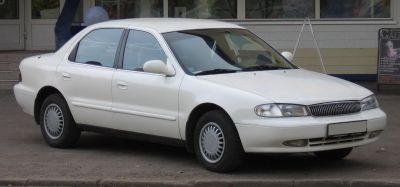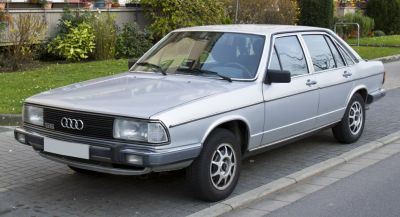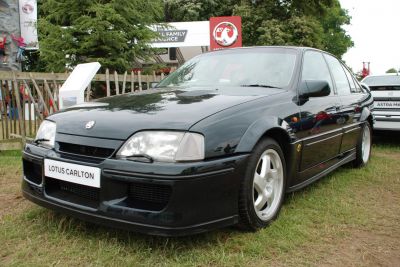 1992 Mazda 626 IV (GE) Dimensions, Size & Specs
1992 Mazda 626 IV (GE) Dimensions, Size & SpecsMeasurements of the 1992 Mazda 626 IV, engineered for optimal performance and comfort
| Dimensions | |
|---|---|
| Length: | 4700 mm185.0 in15.4 ft |
| Width: | 1750 mm68.9 in5.7 ft |
| Height: | 1400 mm55.1 in4.6 ft |
| Trunk Capacity: | 452 liter16.0 cu ft |
| Weight Specifications | |
| Curb Weight: | 1150-1265 kg2535-2789 lbs |
| Maximal permitted Weight: | 1645-1710 kg3627-3770 lbs |
| Tire Specifications | |
| Rims Sizes: | Other Rims:
|
| Tire Sizes: |
|
The Mazda 626 IV (GE) generation, produced from 1992 to 1997, is a midsize sedan known for its balanced dimensions and practical attributes. It features an overall length ranging between 4695 mm and 4700 mm (approximately 184.8 to 185 inches) while maintaining a width of 1750 mm (68.9 inches) and a relatively low height of 1400 mm (55.1 inches). This design gives the car a sleek yet spacious profile, fitting comfortably into the midsize sedan category popular in the early to mid-1990s. The curb weight of the Mazda 626 IV ranges between 1150 and 1265 kg (2535 to 2788 lbs), allowing for moderate fuel efficiency and agile handling while still providing structural robustness. Its maximum weight capacity spans from 1645 kg to 1710 kg (3627 to 3769 lbs), supporting passengers and cargo effectively without compromising stability. A standout feature is its luggage capacity of 452 liters (15.95 cubic feet), which offers ample storage space for daily commuting or longer trips, making it a practical choice for families and professionals alike. The vehicle rides on rim sizes varying from 5.5J x 14 ET 45 to 6J x 15 ET 50, paired with tire options such as 185/70 R14 88H, 195/60 R15 88H, and 195/60 R14, optimizing grip and ride comfort across different driving conditions. Overall, the Mazda 626 IV (GE) sedan blends practicality, comfortable dimensions, and a reliable build framework, making it a compelling midsize option from the 1990s automotive market.
Discover the standout features that make the 1992 Mazda 626 IV a leader in its class
Have a question? Please check our knowledgebase first.
The Mazda 626 IV (GE) Sedan, produced from 1992 to 1997, measures between 4695 mm and 4700 mm (approximately 184.8 to 185 inches) in length. It has a width of 1750 mm (68.9 inches) and a height of 1400 mm (55.1 inches). These dimensions place the vehicle in the mid-size sedan category, offering a balance of interior space and exterior maneuverability.
The curb weight of the Mazda 626 IV (GE) ranges between 1150 kg and 1265 kg (roughly 2535 to 2789 lbs), depending on the specific trim and equipment. Its maximum weight capacity spans from 1645 kg to 1710 kg (about 3627 to 3770 lbs), reflecting the total allowable weight including passengers, cargo, and fluids. The varying curb weights affect fuel efficiency and handling, while the maximum weight outlines the vehicle's load-carrying limits for safe operation.
The luggage compartment of the Mazda 626 IV (GE) offers a generous 452 liters (approximately 15.95 cubic feet) of space. This capacity is quite commendable for a mid-size sedan from the early to mid-1990s, providing ample room for groceries, luggage, or other cargo. Compared to contemporaries, this volume supports versatile daily use, striking a practical balance between passenger comfort and storage.
Yes, the Mazda 626 IV (GE) fits comfortably in a standard residential garage. Standard garage sizes typically range around 2400 mm to 3000 mm (7.9 to 9.8 feet) wide and 4800 mm to 6000 mm (15.7 to 19.7 feet) deep. With a width of 1750 mm (68.9 inches) and length of around 4700 mm (185 inches), the Mazda 626 IV occupies significantly less space than these minimum dimensions, allowing enough clearance for easy parking and door opening inside an average home garage.
The Mazda 626 IV (GE) saw a modest increase in size compared to the Mazda 626 III. The IV generation measures approximately 4695-4700 mm in length, offering a slight extension over the previous generation's length, contributing to enhanced interior space and comfort. The width remained similar at 1750 mm, maintaining the car’s mid-size vehicle footprint. Weight increased slightly due to added features and structural improvements, with curb weight stepping up to a range of 1150-1265 kg from lighter figures in the earlier generation. These incremental size and weight changes allowed the IV generation to deliver better ride quality and safety without compromising maneuverability.
The Mazda 626 IV (GE) offered multiple rim and tire size options to suit driver preferences and performance needs. Rims came in sizes such as 5.5J x 14 ET 45, and 6J x 15 ET 50, accommodating tires sized 185/70 R14 88H, 195/60 R15 88H, and 195/60 R14. These tire designations indicate moderately sized tires appropriate for a mid-size sedan, providing a comfortable ride and stable handling characteristics. The variations allowed for some customization based on trim levels and market requirements.
The Mazda 626 IV (GE) stood competitively among mid-size sedans of the early 1990s. Its length of roughly 4700 mm (185 inches), width of 1750 mm (69 inches), and height of 1400 mm (55 inches) put it on par or slightly larger than competitors like the Honda Accord and Toyota Camry of the period. While these rivals offered similar dimensions, the Mazda 626 often distinguished itself with a sporty design and balanced driving dynamics. The cargo space at 452 liters was also competitive, providing practicality along with a reliable reputation for performance and durability.
Although exact interior measurements can vary, the Mazda 626 IV (GE)’s overall length (around 4700 mm), width (1750 mm), and height (1400 mm) support comfortable seating for five passengers. Its spacious cabin layout was designed to optimize legroom and headroom for both front and rear occupants in the mid-size sedan class. The relatively wide and long body allows for a balanced interior volume that suits family use and daily commuting, maintaining comfort without the bulk of larger vehicles.
The Mazda 626 IV (GE), with its curb weight ranging from 1150 to 1265 kg (2535 to 2789 lbs), was generally regarded as fuel efficient relative to its size during the early to mid-1990s. Depending on engine choice and driving conditions, the car tended to offer respectable fuel economy figures competitive with other mid-size sedans of the time. This efficiency was facilitated by aerodynamic styling and relatively lightweight construction, balancing performance with economy for daily driving and longer trips.
The Mazda 626 IV (GE) incorporated several safety and technological enhancements over previous generations. These included improvements in structural rigidity for better crash protection, updated braking systems, and expanded use of safety features like airbags in various markets. Technologically, the IV generation supported more advanced audio systems, power accessories, and improved climate control options, catering to evolving consumer expectations. These advancements contributed to a more modern, safer driving experience relative to earlier 626 models.
Discover similar sized cars.

| Model Year: | 1978 |
|---|---|
| Length: | 4705 mm185.2 in |
| Width: | 1722-1730 mm67.8-68.1 in |
| Height: | 1410 mm55.5 in |

| Production: | 1996-1998 |
|---|---|
| Model Year: | 1996 |
| Length: | 4696 mm184.9 in |
| Width: | 1770 mm69.7 in |
| Height: | 1420 mm55.9 in |

| Production: | 1979-1982 |
|---|---|
| Model Year: | 1979 |
| Length: | 4683 mm184.4 in |
| Width: | 1768 mm69.6 in |
| Height: | 1390 mm54.7 in |

| Production: | 1976-1979 |
|---|---|
| Model Year: | 1976 |
| Length: | 4680 mm184.3 in |
| Width: | 1768 mm69.6 in |
| Height: | 1390 mm54.7 in |

| Production: | 1979-1982 |
|---|---|
| Model Year: | 1979 |
| Length: | 4695 mm184.8 in |
| Width: | 1768 mm69.6 in |
| Height: | 1390 mm54.7 in |

| Production: | 2012-2014 |
|---|---|
| Model Year: | 2012 |
| Length: | 4729 mm186.2 in |
| Width: | 1782 mm70.2 in |
| Height: | 1465 mm57.7 in |

| Production: | 1986-1994 |
|---|---|
| Model Year: | 1986 |
| Length: | 4768 mm187.7 in |
| Width: | 1933 mm76.1 in |
| Height: | 1435 mm56.5 in |

| Production: | 2001-2007 |
|---|---|
| Model Year: | 2001 |
| Length: | 4731 mm186.3 in |
| Width: | 1812 mm71.3 in |
| Height: | 1429 mm56.3 in |
